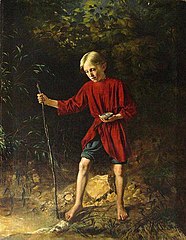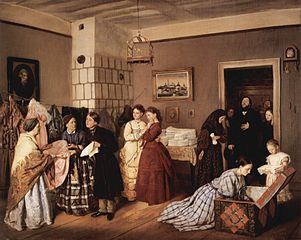Vasili Pukirev
Vasili Pukirev | |
|---|---|
Василий Владимирович Пукирев | |
 Self-portrait (1868) | |
| Born | 1 December 1832 |
| Died | 1 June 1890 (aged 57) |
| Education | Member Academy of Arts (1860) Professor by rank (1863) |
| Alma mater | Moscow School of Painting |
| Known for | Painting |

Vasili Vladimirovich Pukirev (Russian: Василий Владимирович Пукирев; (1832, Luzhniki, Tula Governorate - 1 June 1890, Moscow) was a Russian genre painter in the Realistic style.
Biography[]
He was born to a peasant family and was originally apprenticed to an icon painter in Mogilev. By sheer luck, he was able to enroll at the Moscow School of Painting, Sculpture and Architecture (MSPSA), where he studied from 1847 to 1858 under the direction of Sergey Zaryanko and Apollon Mokritsky.[1] After 1850, he was certified to serve as an art teacher in the public schools. In 1855 he was awarded the title of "Artist" and, in 1858, became a "Free Artist".[citation needed]
In 1860, he became an "Academician" for history and portrait painting. He settled in an apartment near the MSPSA and taught there through 1873.[2] In 1862 and 1864, he was able to travel abroad to "view art galleries" under the sponsorship of the . In 1869, he collaborated with Alexei Savrasov to prepare a drawing course for use in the public schools. In addition to his paintings, he created icons and illustrations for the works of Gogol and Turgenev.[1]
Four years later, he was forced to give up teaching due to poor health.[1] In 1879, his fellow artists got together to provide him with a modest pension, but he died in poverty and nearly forgotten in 1890.[2]
The Unequal Marriage[]
His best known painting is "The Unequal Marriage". Pukirev appears at the far right of the canvas (possibly as best man), giving rise to the story that it represented an episode of lost love in his own life.[2] In 1863, on the basis of this work, he was named an honorary Professor at the Imperial Academy of Fine Arts. It also spawned a heated debate in the press, with his supporters praising it for presenting a serious theme from modern life,[2] unlike the usual genre scenes, which tended to be nostalgic or sentimental. It is currently on display at the Tretyakov Gallery.
Works[]

Boy with Bird's Nest (1856)

The Gambler (1865)

In the Artist's Studio (1865)

Reception of a Dowry in a Merchant Family (1873)

Wedding Interrupted (1877)
References[]
- ^ Jump up to: a b c Brief biography @ RusArtNet.
- ^ Jump up to: a b c d Brief biography @ Russian Painting.
External links[]
| Wikimedia Commons has media related to Vasili Pukirev. |
- Biography, quotes and extensive list of paintings from the Russian Biographical Dictionary @ Russian WikiSource.
- "The Unequal Marriage" an appreciation of the painting at "Zhivopis".
- "The Unequal Marriage" a video presentation by the Tretyakov Gallery @ YouTube (10:24 minutes, Russian)
- Members of the Imperial Academy of Arts
- Professors by rank of the Academy of Arts
- 19th-century Russian painters
- Russian male painters
- 1832 births
- 1890 deaths
- Russian genre painters
- People from Tula Governorate
- Russian illustrators




